How to cook with scented geraniums
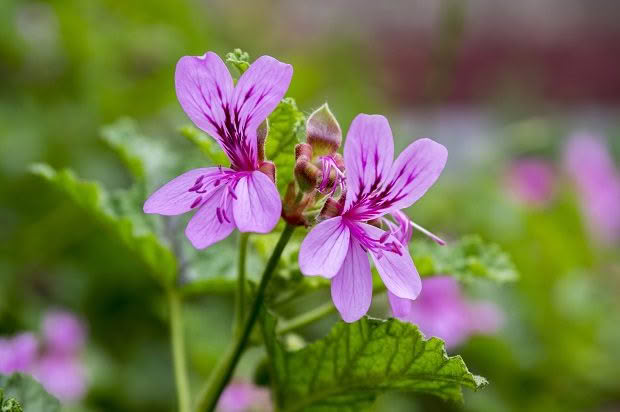
Words: Jenny Somervell
The geranium has always been a garden favourite, but there are also varieties that add a sweet touch to your cooking.
Our first cooking experiments with scented geraniums had mixed results. We discovered that some leaves smelled better than they tasted, sweeter dishes worked better, and piney, resinous, camphoraceous scents didn’t work so well. These were better matched with very assertive flavours or avoided altogether.
To test the flavours we placed a range of leaves from different varieties in the bottom of muffin tins, filled the tins with our muffin mixture, labelled them and then tasted them after cooking. Our son loved these kinds of science experiments.
There were a few clear winners. I liked the rose and most of the lemon varieties, with the exception of ‘Mabel Gray’ which was a bit strong for my liking, but well worth trying with fish. For a fresh zing, put peppermint-scented leaves (P. tormentosum) under a chocolate cake. Amazing!
The best scents for cooking were rose, lemon and mint-flavoured geranium or combinations of the three.
We had fun flavouring cakes by arranging leaves in the bottom on a lined or buttered tin before pouring batter over them. Our not-so-new discovery – that the flavours infused into the cake mixture during cooking – created some unique eating experiences. However, the leaves are best removed before eating. Munching leaves in cakes and muffins is not so delicious.
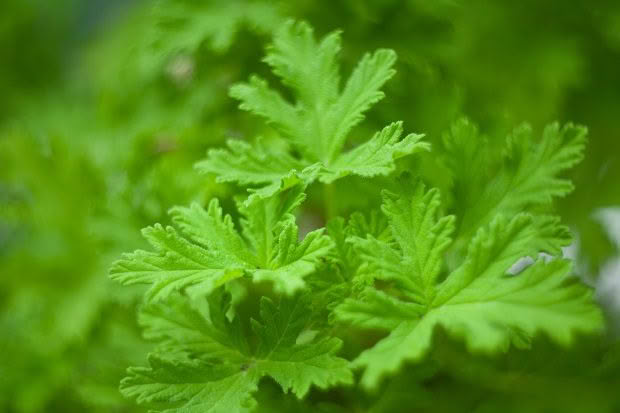
TURNING JELLY INTO SOMETHING EXTRA SPECIAL
Scented geranium leaves can make a fruit jelly something special. The delightful apple-scent of P. odoratissimum is used in Mediterranean countries to flavour apple jelly. Two or three leaves of rose-scented geranium are delicious with berries and currants. Simply pour hot jelly into jars with a few scented geranium leaves in them.
Alternatively, you can dunk bunches of tied leaves into the jelly just before removing it from the heat.
POSIES AND TUSSI MUSSIES
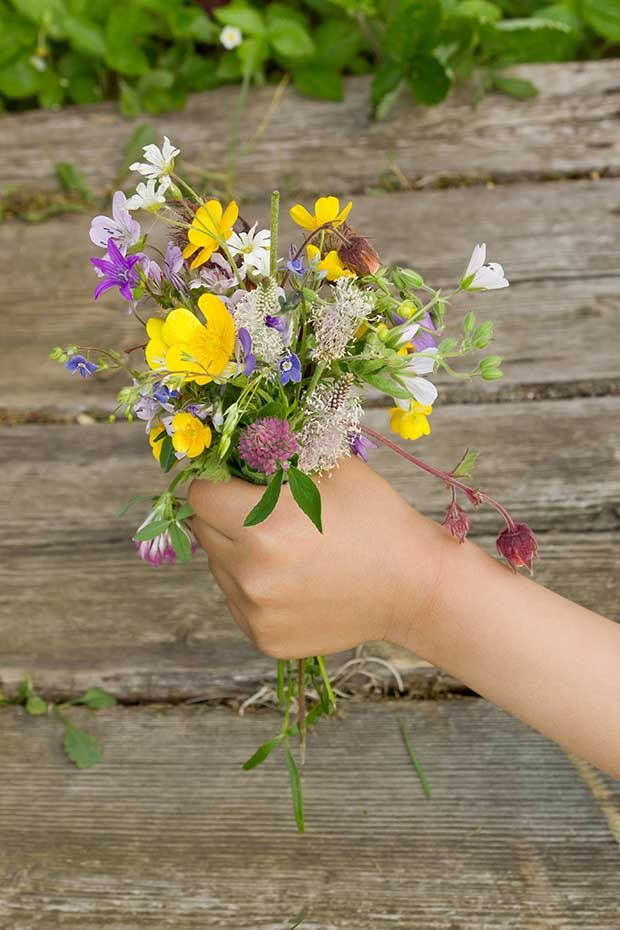
If you don’t get around to cooking you can simply pick stems and arrange them in a vase with other seasonal flowers. The leaves (not the flowers) will last for weeks and add fragrance, texture, and shape to any arrangement.
Better still, you can make a tussie-mussie which is simply a small bouquet of fresh herbs and flowers. These delightful posies are bound just below the foliage giving the bouquet a flat-topped look. All you need is a paper doily or decorative floral paper and some festive ribbon to tie at the base and you have a delightful hand-made gift.
Scented geraniums suit pot pourri too. Lemon-scented geraniums can be substituted for lemon herbs, rose-scented for rose petals. Dry the leaves on racks (out of direct sunlight) in a place that has good air circulation and an air temperature of 21°C-32°C. You will know they are dry when the leaf stalks break with a snap.
Scented geraniums combine well with lavender flowers, rose petals, and lemon, rose or mint-scented leaves, along with spices like cinnamon sticks, coriander seeds, and mace.
From garden to posie to plate, we have found scented geraniums to be a delight to the senses and fabulous fodder for the experimental gardener/cook. It’s all up to your imagination, your nose, and your taste buds!
A NOSE FOR ROSES
Have you ever noticed how many of the so-called rose-scented cosmetics lack the true soft, sweet rose scent? It was only when I went to buy genuine rose essential oil that I discovered why. It’s because the true ‘Attar of Rose’ oil derived from rose petals is extracted in such tiny quantities that it costs a fortune.
But in 1847 the French distilled the oil from the rose-scented geranium Pelargonium graveolens. They noted its fresh, light rose scent and soon recognised its potential as a substitute for rose oil. It’s easy to see why: it’s stable and long-lasting, and it provides a much cheaper alternative to expensive rose oil.
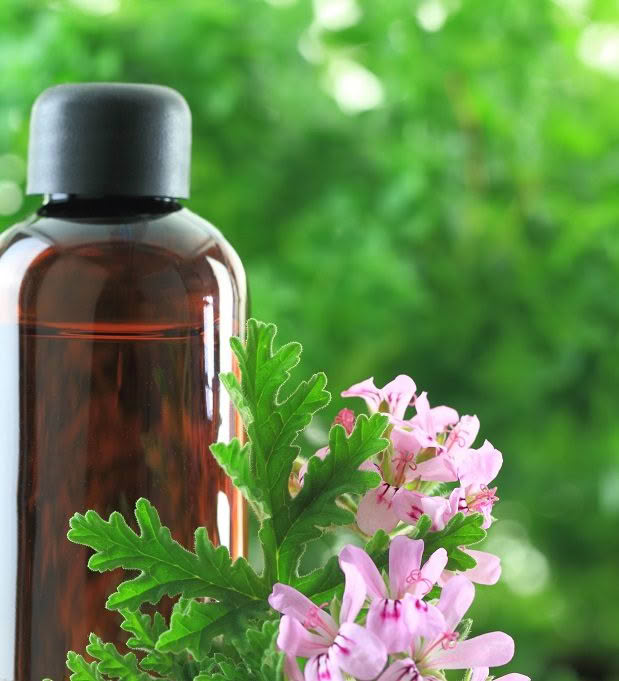
Geranium essential oil, distilled from P. graveolens, smells like rose essential oil but can be produced far more cheaply.
Geranium oil is used widely in perfumes, scenting soaps and other cosmetics. It is also added to face creams to help balance the sebum in oily, dry or inflamed skin.
Medicinally, the essential oil has been used in the treatment of skin disorders such as dermatitis, eczema and dry skin. Added to massage oil, it is a tonic for the nervous system and is used to relieve PMT, fluid retention and poor circulation.
It is valued in aromatherapy as refreshing, relaxing and astringent.
TIPS FOR COOKING WITH SCENTED PELAGRONIUMS:
IN DESSERTS
✿ Chop finely or infuse in water or syrup, then discard leaves.
✿ Add to sauces, custards, jellies, buns, water ices, jams, syrups, and vinegars.
✿ Crystallise to decorate cakes.
✿ Lay leaves under baked apples or cakes (remove before serving).
Note: 1-3 leaves is usually enough to flavour a dessert.
IN TEAS
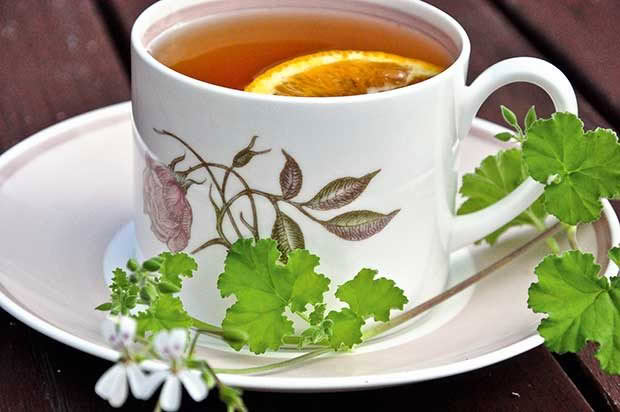
China tea with apple-scented geranium (P odoratissimum).
✿ Infuse 1-2 leaves of rose, apple or lemon geranium per cup of hot water along with China tea. Add a few cloves and/or orange or lemon slices.
✿ For iced tea, cool and pour into a jug of ice and flavour with geranium sugar. For a decorative, flavoursome touch, add the small leaves of lemon or mint-scented geraniums to your ice cube trays. These are great in punch too!
IN VINEGARS
✿ Add lemon and rose-scented geraniums to sweet vinegars. Combine with lemon verbena, lemon basil and mints. Use to add zest to salads, vinaigrettes, marinades
RECIPE: ROSE CREAM
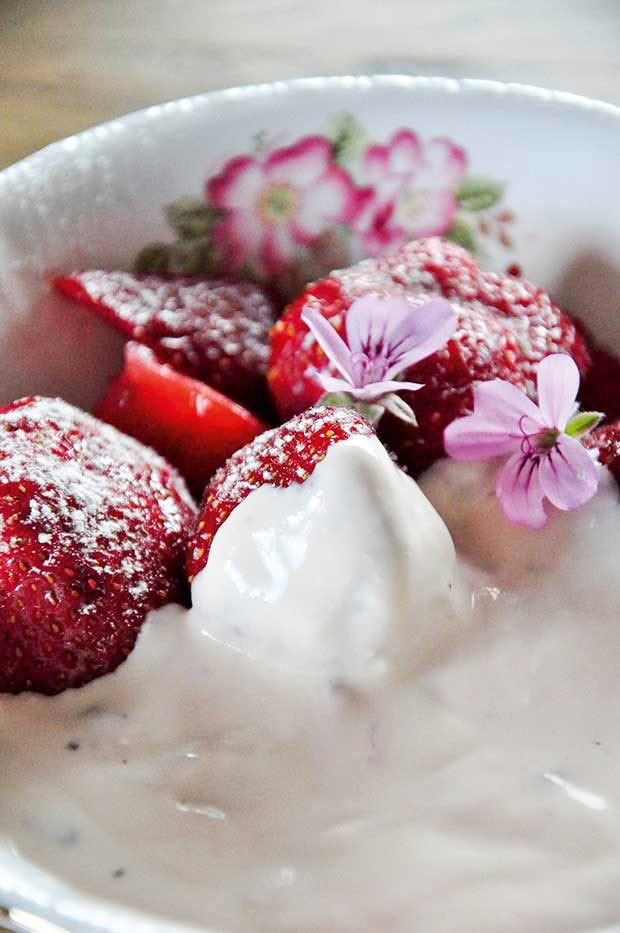
■ 300ml fresh cream
■ 4 Tbsp castor sugar
■ 4-6 rose geranium leaves
■ 6-8 fresh boysenberries (or thawed frozen berries)
■ 250g sour cream (or cream cheese)
Note: berries add colour, but you can substitute 1-2 drops of food colouring)
Heat the cream, sugar and the geranium leaves in a pot, stirring frequently, until just short of boiling, but do not boil. Remove from heat and allow to cool. Mash the berries to a puree. Beat the sour cream until smooth and add the berry puree. Beat again to blend the berry puree into the sour cream. Strain the geranium leaves out of the cream and sugar, and fold into the sour cream mixture – mix gently with a spoon until combined. Cover and place in the fridge to chill for several hours or over night. Serve on fresh summer berries or fresh fruit salad in place of cream/yoghurt.
RECIPE: ROSE-FLAVOURED RHUBARB CRUMBLE
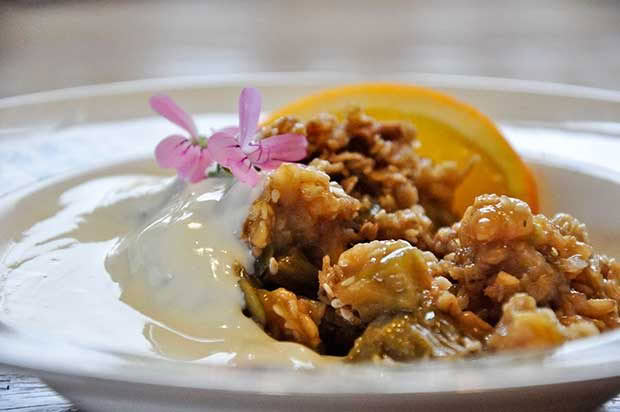
■ rind & juice of two oranges
■ ¾ cup extra juice
■ 6-8 rose-scented geranium leaves
■ ¾ cup brown sugar
■ 2 Tbsp cornflour
■ 10-12 trimmed stalks of rhubarb
Roughly chop the geranium leaves and heat gently in a pan with the orange juice. Bring to near the boil but do not boil, then remove from heat and allow to infuse as it cools. Chop the rhubarb stalks into 1cm chunks and place in baking dish. You will need to fill (but not overfill) the dish with raw rhubarb to have the right amount when cooked. In a large bowl mix the sugar, cornflour and orange rind, tip the rhubarb in and mix well.
Grease the baking dish and pour the rhubarb mixture back into it, spreading the dry ingredients evenly across the mix. Strain the orange juice and pour over the rhubarb mix. Pack with the crumble topping, pressing the crumble firmly over the rhubarb and around the edges of the dish. Bake at 180°C for 45 minutes. Turn oven off and leave so it stays warm until ready to eat. This subtly-flavoured dessert is delicious. Serve with cream, yoghurt, ice cream or rose cream (recipe at left).
CRUMBLE
Use your own recipe or the following:
■ ¾ cup brown sugar
■ 1 cup whole rolled oats
■ 1 cup fine rolled oats
■ ½ cup of mixed seeds and chopped nuts, eg pumpkin, sesame and sunflower seeds, walnuts, almonds
■ 2 Tbsp soft butter
Mix all the dry ingredients together and rub in the butter. Recipes adapted from Mary Browne & Nancy Tichbourne, The Cook’s Herb Garden
RECIPE: ROSE-SCENTED SUGAR
✿ Place alternate layers of rose-scented pelargonium leaves and castor sugar in a dry glass jar until the container is full. Cover tightly and leave in a warm place for a week or more. Shake from time to time.
✿ Sieve before using and sprinkle on custards, biscuits or sponge cakes.
✿ To use, substitute for plain sugar in white cakes and icings for a unique and subtle flavour.
ROSE-SCENTED GERANIUM VARIETIES
Rose (P. graveolens)
Height: up to 1m+
Downy, grey-green leaves with five major lobes which are deeply cut and toothed. The scent ranges from light to strongly rose-scented depending on the variety (of which there are many). Small rose-pink flowers with dark red veins are borne in clusters. Grows to a large, shrubby plant. Comes from South Africa where it grows in moist sites in semi-shade.
Rose ‘Lady Plymouth’
Height: up to 1m+
A sort of P. graveolens with gray-green divided leaves that are edged and sometimes splotched with pale cream. Makes a great container plant. Good for pot pourri and floral work
Rose (P. capitatum)
Height: low growing with sprawling stems to 60cm or longer
Introduced to Britain in 1690, this is the rose-scented geranium of cottage gardens, manor houses and greenhouses. Grows on sand dunes in its native South Africa. Velvety heart-shaped leaves with three to five lobes and toothed edges. Pink flowers are born in tight umbels. Often misnamed.
P. x capitatum ‘Attar of Roses’ syn ‘Otto of Rose’
Height: up to 30cm
Ruffled, hairy leaves have a stronger scent and are more deeply lobed than other species.
Love this story? Subscribe now!
 This article first appeared in NZ Lifestyle Block Magazine.
This article first appeared in NZ Lifestyle Block Magazine.
